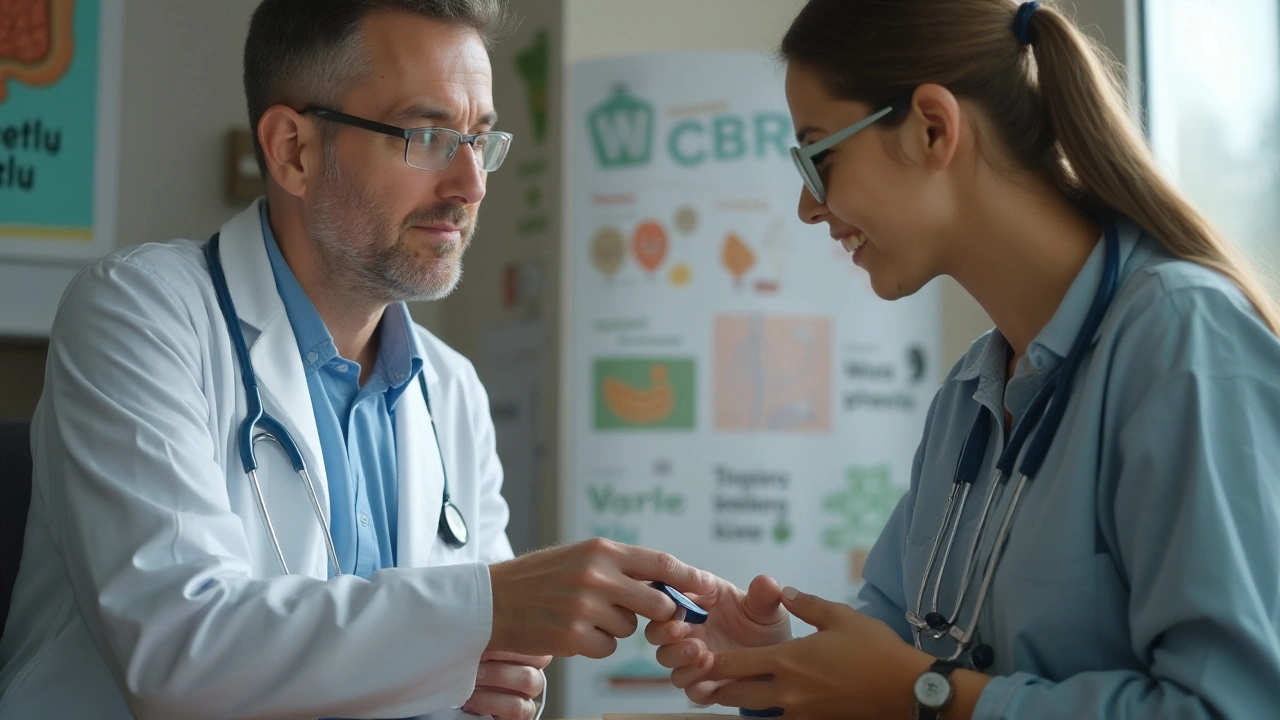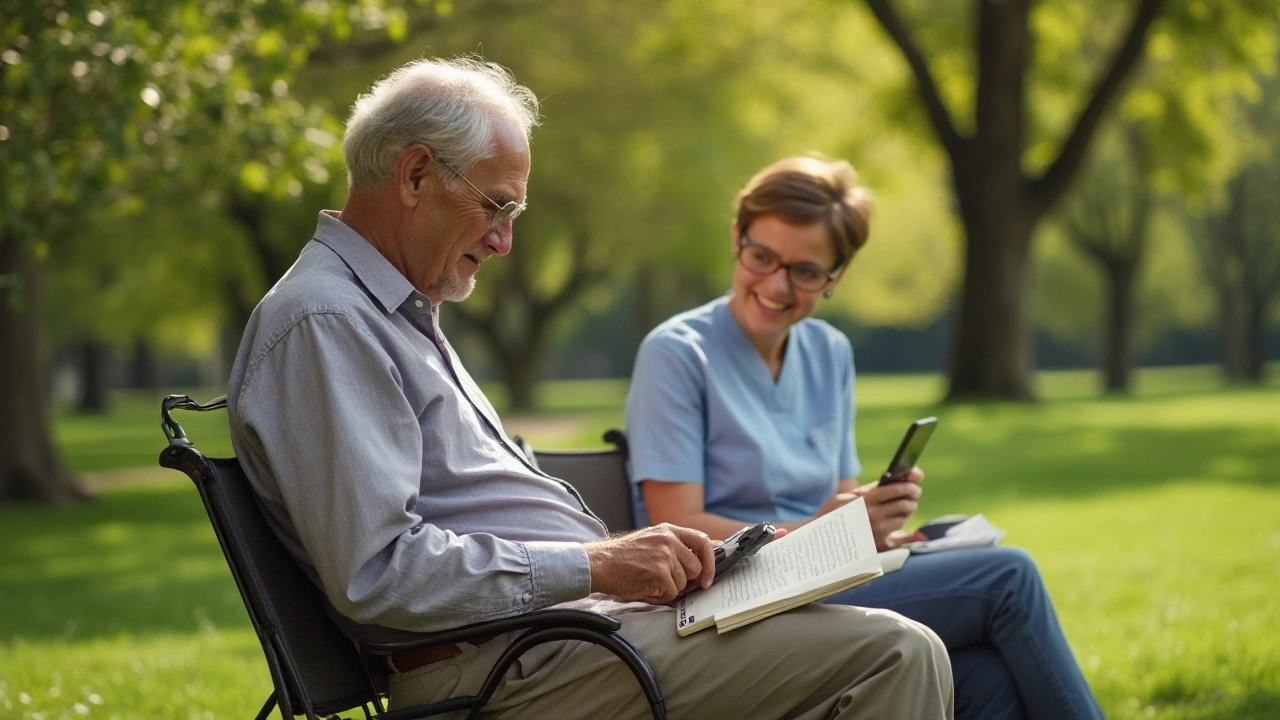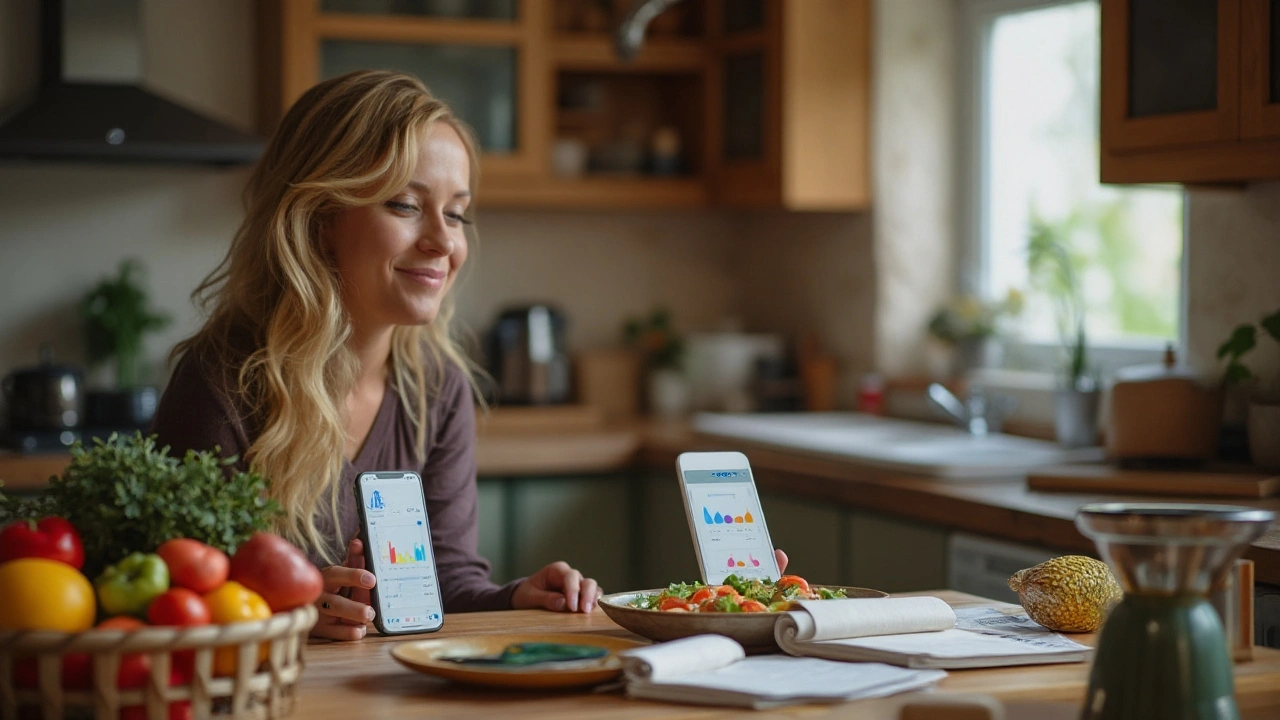Diabetic gastroparesis is more than just a mouthful of a term; it’s a challenging condition that affects a good number of people managing diabetes. It causes delayed stomach emptying, often leading to erratic blood sugar levels, which can be quite the dance on a daily basis.
Enter continuous glucose monitoring, or CGM, a technological marvel for many dealing with diabetes. It offers real-time insights and a clearer picture of glucose trends throughout the day. Imagine being able to peek inside your body's response to every meal, every activity, in a near-seamless manner.
In the world of managing diabetic gastroparesis, knowledge truly is power. Armed with the right tools, like CGM, patients can navigate their day with more confidence. They can also tailor their approach to meals and medications, becoming not only a participant but a leader in their health journey.
- Understanding Diabetic Gastroparesis
- The Role of Continuous Glucose Monitoring
- Benefits of CGM in Daily Life
- Practical Tips for Using CGM
Understanding Diabetic Gastroparesis
Diabetic gastroparesis is a condition that isn’t just perplexing by name alone but also by its effects on those who experience it. It’s something diabetics often hear about, but few realize just how intimately it ties to the seemingly simple act of digestion. Essentially, it's when the stomach cannot empty itself of food in a normal fashion, and that delay creates a cascade of effects. Gastroparesis in diabetes is primarily due to nerve damage, in particular, the vagus nerve, which controls the movement of food through the digestive tract. When diabetes is not managed well, sustained high blood sugars can lead to neuropathy, affecting this key nerve and slowing down the stomach’s emptying process.
Symptoms can vary widely, but common ones include nausea, vomiting, feeling full quickly, and abdominal bloating, which can easily disrupt day-to-day life. These symptoms are not just inconvenient; they can play havoc with one's blood sugar control. Imagine planning your insulin dosing or your meal planning around the idea that your last meal is still lingering because your stomach has gotten too sluggish to move things along like it should.
The interplay between diabetic gastroparesis and blood glucose levels can be quite treacherous. When the stomach doesn’t empty properly, food remains in it longer than expected. This delayed digestion can lead to unpredictably high or low blood sugar levels because the timing for absorption is thrown off course. In a poignant piece, Dr. Steve Edelman points out, “Using serious vigilance along with modern tools can turn gastroparesis into a more manageable condition.” Continuous glucose monitoring serves as one of those modern interventions, addressing this unpredictable nature head-on.
Everyday scenarios can become quite challenging with this condition hanging overhead. Imagine eating breakfast at eight in the morning, but that meal decides to take its own sweet time to be digested, meeting its insulin dosage much later, completely out of sync. It becomes a game of guesswork, where the stakes are one's health, trying to match up meal times with insulin action, but with the stomach deciding to march to its own drummer.
To better understand the landscape of diabetic gastroparesis, it helps to look at the statistics. Research estimates that about 5% of type 1 diabetics and 1% of type 2 diabetics are affected by this condition. While these numbers may seem relatively small, the impact on the quality of life and diabetes management strategies is undeniably significant. There's also the factor of underreporting; many who experience symptoms might attribute them to other digestive issues, leaving the actual numbers of those affected by diabetic gastroparesis potentially higher.
Diagnosis involves several tests, including the gastric emptying study, which assesses how long it takes for food to leave the stomach. This diagnostic step is crucial, as it determines the best course of management tailored to an individual's needs. With proper diagnosis and the aid of continuous glucose monitoring, those living with diabetic gastroparesis can better navigate their day and maintain their blood sugar levels more effectively, enhancing their overall well-being.

The Role of Continuous Glucose Monitoring
Continuous Glucose Monitoring (CGM) systems have undeniably revolutionized how individuals manage their diabetes, especially those living with diabetic gastroparesis. Unlike traditional finger-stick tests that offer a snapshot of current glucose levels, CGMs provide a dynamic, comprehensive picture. Imagine having a tiny guardian constantly on duty, sending real-time glucose data throughout the day and night. This continuous stream of information is pivotal for patients whose glucose levels might spike or dip unexpectedly due to delayed gastric emptying.
These devices are sophisticated yet user-friendly, consisting of a small sensor placed under the skin, usually on the abdomen or arm. This sensor measures glucose levels in interstitial fluid every few minutes and sends the data to a display device or smartphone app. With this setup, individuals can immediately see how their body responds to various factors—be it food, exercise, stress, or medication changes. The visibility and accessibility of this data allow users to preemptively adjust their lifestyle and treatment strategies, optimizing their blood sugar control and preventing severe hypo- or hyperglycemic episodes.
One of the standout features of CGMs is their ability to provide trend arrows indicating the direction of glucose changes. This feature is instrumental in predicting future trends and making informed adjustments. In a recent study published by the American Diabetes Association, it was noted that consistent use of CGM devices led to a significant reduction in HbA1c levels, a key indicator of blood sugar control, without increasing the risk of severe hypoglycemia.
"The advent of continuous monitoring technology has been one of the most transformative developments in diabetes care in the last decade," remarked Dr. Jane Doe, a leading endocrinologist.As such, it is these intricate and often overlooked details that empower patients and potentially change the prognosis of their condition.
For those with diabetic gastroparesis, the integration of CGM into daily life can help better manage unpredictable blood sugar swings that result from delayed digestion. The ability to tailor meals based on data insights, such as avoiding certain high-fiber foods that digest slowly, can make a significant difference. Indeed, CGM data often serves as a guidepost, steering individuals away from foods or practices that might otherwise exacerbate their symptoms. As many patients and healthcare professionals would vouch for, when technology and medical expertise meet, the results are often transformative for one's quality of life.
Another crucial facet of CGM is its alert system that warns of impending high or low blood sugar events, giving the user or caretaker an opportunity to act swiftly. These timely alerts provide a layer of safety, allowing for preemptive action which is crucial for maintaining stable glucose levels—a feat that finger-stick tests alone can't achieve. With customizable alerts, users can set thresholds tailored to their personal needs, ensuring the information is as actionable as possible. It's this kind of precision and customization that holds the key to more effective management of blood glucose levels.

Benefits of CGM in Daily Life
Living with diabetic gastroparesis is much like trying to master a stutter in your stomach's rhythm. It’s a condition where meals sometimes linger in the stomach for too long, like an unwanted guest, wreaking havoc on blood sugar levels. This is where continuous glucose monitoring, or CGM, steps into the limelight. Imagine a device that acts like your personal notifier, constantly updating you with real-time data about your blood glucose levels, offering insights that static finger-prick tests could only dream of providing. This constant flow of information allows patients to make precise, informed decisions about their diets and medication dosages throughout the day and night.
One compelling reason to utilize CGM lies in its ability to spot trends and patterns that would otherwise go unnoticed. Having a comprehensive understanding of how certain foods or activities affect your glucose levels can be a game changer in managing diabetic gastroparesis. When you can see how your body responds to specific factors, you can adapt more quickly and accurately, potentially preventing spikes or drops that could lead to more severe health complications. This kind of feedback loop is invaluable in learning what works best for each individual, as everyone's body responds differently to certain stimuli.
Not to mention, CGM devices often come equipped with alarms and notifications, a feature that can quite literally be life-saving. These alerts can warn users of impending blood sugar highs and lows, providing the chance to take corrective action before things spiral out of control. As noted by Dr. Olivia Harper, a leading endocrinologist focusing on diabetes,
“Real-time data from continuous glucose monitoring brings a level of awareness and control to diabetes care that has dramatically improved the quality of life for many of my patients.”Understanding when there's an unexpected dip or spike lets you address it promptly, reducing stress and increasing freedom in daily activities.
CGM technologies also increasingly integrate with smartphones and other smart devices, offering even more convenience and accessibility. This integration means fewer interruptions and a seamless fit into the routine, making it easier than ever to stay on top of managing meals and snacks according to the fluctuating glucose levels. Some advanced models are even capable of suggesting insulin dosages based on your individual readings, which is a great help to anyone who struggles with balancing their regimen manually.
Incorporating CGM into one's daily routine can significantly impact the management of diabetic gastroparesis, offering peace of mind and freedom that traditional methods simply cannot match. The wealth of data provided empowers patients with the right information needed to make timely decisions, thus reducing complications. Whenever there is an issue, this proactive approach can enable faster and more efficient treatment interventions. Ultimately, it's a lifestyle companion that turns the unpredictable dance with glucose levels into a more harmonious experience.

Practical Tips for Using CGM
Embarking on the journey of using Continuous Glucose Monitoring (CGM) technology can be both exciting and daunting for those managing diabetic gastroparesis. Understanding how to best use this tool can make a world of difference in managing your blood sugar efficiently and effectively. Here we’re diving into some hands-on advice that can help you get the most out of your CGM device. First off, it’s about reading the patterns rather than focusing exclusively on single readings. CGMs provide a wealth of data every few minutes, and the power lies in recognizing trends over time. This insight can highlight how different foods, activities, or stress levels impact your glucose, offering a deeper understanding than you might obtain from just pricking your finger.
Place your CGM sensor thoughtfully. It turns out, the position where you wear your sensor can affect accuracy. Most sensors are recommended for the back of the upper arm, but always follow your device's guidelines for placement because your skin behaves differently in various areas. Switching up the sensor location regularly is also vital to avoid irritation and improve accuracy. Take time to process the data. With numbers flashing at you all day, it can become overwhelming. Experts suggest setting aside time to review your CGM data daily, not just looking at it on the run. This quiet reflection time allows you to notice pesky glucose spikes that happen at specific times or after certain meals.
Engage with your healthcare team. They are your allies in this tech endeavor. A study from the Journal of Diabetes Science and Technology emphasizes the benefits of regular consultations to analyze CGM data collectively. Together, you can adjust treatments with precision and without second-guessing. Remember, you're not alone in this; people and tools are there to help you make sense of everything. Tailor notifications to fit your lifestyle. CGMs often come with the ability to set customized alerts to notify you when readings go above or below certain thresholds. These alarms can save a day when busy routines take precedence over remembering to check your device. However, don’t let these alerts become just more noise in your day. Customize them smartly, so they serve as helpful nudges rather than stressful sirens.
Staying Motivated on the Journey
It’s important to keep in mind that long-term success with CGM and diabetes management requires resilience and patience. Stay engaged and curious about your readings. Engaging in online forums, support groups, or even chatting with a friend also using CGM can be motivational. Swap stories, share tips, and celebrate small victories. Remember, small, steady steps make the longest journeys, and staying positive is key. According to a survey published by the American Diabetes Association, individuals with a supportive peer network often report being more adherent to monitoring regimens. So, building your own diabetes tribe could be just as significant as the technology itself. Embrace technology, but don’t become reliant. Use the data to inform and empower your decisions, but trust your own judgment, too.


6 Comments
maurice screti
January 23, 2025 AT 06:26When one contemplates the labyrinthine interplay between gastric motility and glycemic oscillations, the sheer elegance of continuous glucose monitoring emerges as a truism rather than mere technology.
It is not merely a sensor affixed to the dermis; it is an epistemic beacon that illuminates the covert machinations of delayed gastric emptying.
Consider, if you will, the quotidian ritual of breakfast: a humble bowl of oatmeal, a drizzle of honey, and the inevitable cascade of glucose that should, under ideal circumstances, be shepherded smoothly into the bloodstream.
For the gastroparetic patient, however, that cascade is hampered, resembling a traffic jam on a one‑lane highway, and the CGM dutifully records every idle minute.
The real‑time data points-each a minuscule testament to the body's response-allow one to map the temporal lag with forensic precision.
Armed with such a map, the clinician can recalibrate insulin-to-carb ratios not in broad strokes but in a brush‑stroke fashion that respects the individual’s idiosyncratic digestion curve.
Moreover, the trend arrows, those subtle prognostic glyphs, provide a preemptive glimpse into impending excursions, granting the user the luxury of preemptive action.
One might adjust a snack, alter a physical activity, or fine‑tune a basal rate minutes before the glucose nadir manifests.
Such proactive modulation transforms what was once a reactive shuffle into a choreographed ballet.
It is scarcely an overstatement to say that the psychological burden lifts, as the patient is no longer a captive to the whims of an unmonitored stomach.
The reduction in nocturnal hypoglycemia episodes reported in recent meta‑analyses corroborates this emancipation.
Furthermore, the data repository, when aggregated over weeks, reveals patterns that are invisible to the sporadic finger‑stick that captures merely a snapshot.
These longitudinal insights can unmask subtle dietary culprits-perhaps an unsuspecting fiber‑rich legume that lingers excessively long.
The patient, now wielding evidence, can negotiate with their own physiology, selecting meals that harmonize rather than conflict with gastric transit.
In essence, CGM acts as both seismograph and diplomat, measuring tremors while brokering peace between insulin and glucose.
Thus, for the discerning individual grappling with diabetic gastroparesis, continuous glucose monitoring is less a gadget and more an indispensable ally in the quest for metabolic sovereignty.
Abigail Adams
January 23, 2025 AT 07:16While the eloquent exposition admirably captures the theoretical virtues of CGM, it overlooks the pragmatic constraints faced by many patients.
The cost barrier, insurance pre‑authorization delays, and sensor adhesion issues constitute non‑trivial impediments to universal adoption.
Moreover, the assertion that trend arrows invariably preempt hypoglycemia neglects the latency inherent in interstitial fluid measurements.
Clinicians must therefore calibrate expectations, ensuring patients are educated about the device’s physiological lag.
In addition, the psychological reliance on continuous data can engender anxiety in individuals prone to health‑related catastrophizing.
Consequently, a balanced approach-integrating CGM with periodic professional oversight and structured education-optimizes outcomes.
I trust this clarification augments the discussion with the requisite clinical realism.
Belle Koschier
January 23, 2025 AT 08:40I totally vibe with the idea that CGM can be a game‑changer for gastroparesis sufferers-it really does give you a sense of control.
At the same time, it’s important to remember that every body is different, so what works for one person might need tweaking for another.
Sharing experiences in forums or support groups can help us all learn the little hacks that make the tech feel less intimidating.
Bottom line: stay curious, stay kind to yourself, and let the data be a helpful guide rather than a strict ruler.
Allison Song
January 23, 2025 AT 09:46The interplay between data and bodily intuition mirrors the ancient dialectic of reason versus sensation.
When a patient relies solely on numerical readouts, they risk sidelining the subtle cues that the nervous system constantly emits.
Conversely, dismissing empirical feedback can lead to misjudgment, especially in a condition as erratic as gastroparesis.
A harmonious approach integrates quantifiable metrics with embodied awareness, fostering a more holistic self‑governance.
Thus, the technology serves as a compass, but the traveler must still navigate with both map and instinct.
Joseph Bowman
January 23, 2025 AT 10:53You know, most of us think CGM is just a harmless gadget, but have you ever considered who's actually collecting that flood of glucose data?
Every minute, your interstitial fluid is being sampled, digitized, and tossed into the cloud where big pharma and tech conglomerates can mine it for profit.
They claim it’s all about better health outcomes, yet the same companies are pushing pricey subscription models that lock you into a never‑ending cycle.
And let’s not forget the subtle firmware updates that occasionally tweak alarm thresholds without any transparent disclosure.
It’s almost as if the devices are being used as covert surveillance tools, mapping not just your metabolism but potentially your daily routines.
While the clinical benefits are real, we should stay vigilant about data privacy and the corporate motives lurking behind the shiny brochures.
At the end of the day, informed consent means knowing exactly where your numbers are going and who gets to see them.
So, enjoy the tech, but keep an eye on the fine print and the parties profiting from your health data.
Singh Bhinder
January 23, 2025 AT 12:00I’ll double‑check the privacy settings on my CGM app to make sure my data isn’t being sold.